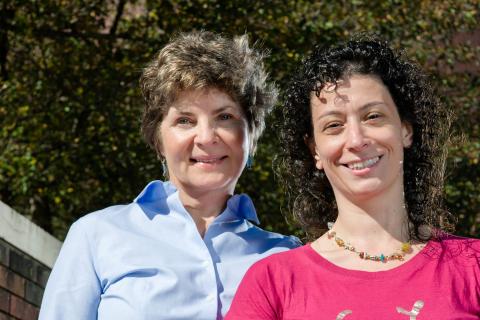
From left: Elena Chertova, Ph.D., head, Retroviral Protein Chemistry Core, AIDS and Cancer Virus Program, Frederick National Laboratory for Cancer Research, and Cristina Bergamaschi, Ph.D., staff scientist, Human Retrovirus Pathogenesis Section, Vaccine Branch, Center for Cancer Research
By Nancy Parrish, Staff Writer![]()
Editor's note: Platinum Highlight articles are noteworthy publications selected periodically by Dr. Craig Reynolds, associate director, National Cancer Institute, from among the most recently published Platinum Publications
Cytokines are proteins that play a crucial role in the human immune system by delivering messages that trigger the activation of immune cells to fight off attacks from viruses or other invaders.
Cristina Bergamaschi, Ph.D., NCI Center for Cancer Research, has been studying the mechanism of expression and function of a cytokine known as interleukin-15 (IL-15) for the last five years, in collaboration with Elena Chertova, Ph.D., and other researchers in the Retroviral Protein Chemistry Core (RPCC) of the AIDS and Cancer Virus Program (ACVP), Frederick National Laboratory for Cancer Research.
A form of human IL-15 produced in Escherichia coli (E. coli) is in initial testing in the clinic, but, according to Bergamaschi, staff scientist in Human Retrovirus Pathogenesis Section (HRPS), Vaccine Branch, “it poses multiple challenges for clinical use due to its instability and rapid plasma clearance.”
The group’s previous findings revealed that “circulating IL-15 exists exclusively in association with soluble IL-15R alpha (sIL-15R?),” Bergamaschi said. This type of structure is known to biochemists as a heterodimer. These findings suggest that the “IL-15 heterodimer is the natural, biologically relevant form of the cytokine in vivo,” she added.
In a 2013 paper published in the Journal of Biochemistry, co-authors Chertova, head, RPCC, and Bergamaschi describe the development of a systematic way to reproduce the natural steps of production and processing of IL-15/sIL-15R? in engineered human cells. They also describe a method for efficiently purifying these heterodimers, which, in mice, were shown to last longer in the bloodstream, to be more stable, and to produce a more potent immune response than IL-15 monomers.
This complex of IL-15 and sIL-15R? “prolongs the bioavailability of IL-15 in the organism,” Chertova said. Such heterodimers “could be more potent than monomeric IL-15 for stimulating the immune system against diseases, such as cancer,” Bergamaschi said, and their properties “provide a strong rationale for the evaluation of this molecule for clinical applications.”
Chertova, who earned her doctorate at Shemyakin Institute of Bioorganic Chemistry, Russian Academy of Sciences, Moscow, joined ACVP in 1994 and became head of the RPCC in 2004. Bergamaschi earned her doctorate in molecular medicine, specializing in immunology, from the University of Milan, Italy, in 2008. Following a postdoc under the supervision of George N. Pavlakis, M.D., Ph.D., she became a staff scientist in the HRPS, headed by Barbara K. Felber, Ph.D., in 2012.
The next step in their research is the evaluation of the effects of IL-15 heterodimers in macaques, to guide the clinical development of IL-15/sIL-15R?. They will also work on large-scale production and purification of the heterodimers to generate current Good Manufacturing Practice (cGMP) material that may be used in additional studies; develop methods to test the material’s stability, purity, and activity; and design a Phase I clinical trial against cancer. IL-15/sIL-15R? will be the first recombinant protein that is a non-covalently linked heterodimer to be produced under cGMP regulations.
Follow this link to view the abstract.

